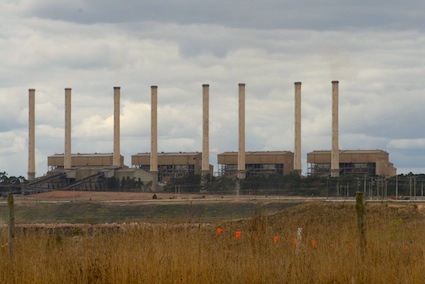The Tasmanian Climate Action Council has made a good start to a long-term climate action plan for the state. [27 July 2010 | Peter Boyer]
There was barely a murmur of dissent two years ago when Tasmania locked itself into a legally-binding regime requiring our carbon emissions in 2050 to be at least 60 per cent below those of 1990.

Hazelwood in Victoria’s Latrobe Valley. A growing proportion of Tasmanian electricity is produced by Victorian coal-fired power stations. PHOTO WIKIPEDIA COMMONS
Some MPs who supported the Climate Change (State Action) Act may have felt the target was modest, well within our capabilities. But two years on it looks ambitious. We might call it courageous — except for the fact that its deadline is still 40 years away.
Far-away targets can look good on paper, casting their authors in a visionary glow, but when the time comes to account for what’s been done, or not done, between now and then, those responsible for the legislation will have long since departed the scene. The next generation will carry the can.
Today things don’t look all that rosy. Far from dropping, our emissions are currently rising at business-as-usual levels, at the rate of around one per cent a year. If we maintain that trajectory we’re facing a 45 per cent increase by 2050 — about three times the legislated limit.
The first systematic look at reducing Tasmanian carbon emissions was a report by Melbourne-based consultants McLennan Magasanik Associates, released in February by the now-departed climate change assistant minister, Lisa Singh. Its significance got lost in the heat of the 2010 Tasmanian election campaign, which saw climate action relegated to the back of the grandstand.
With the election behind us, we now have another opportunity to look at how our relentlessly rising emissions might be cut back, courtesy of Opportunities to Reduce Tasmania’s Greenhouse Gas Emissions, a response to the MMA report prepared by the Tasmanian Climate Action Council.
On establishing the 10-member TCAC early last year under the Climate Change (State Action) Act, premier David Bartlett challenged it to be a crucible for “the bold ideas that will place Tasmania in a leadership position in the emerging low-carbon economy”.
Doing nothing about climate change is not an option, as climate change minister Nick McKim pointed out on receiving and releasing the report earlier this month. TCAC chair Professor Kate Crowley said she looks to “robust political and community debate” on how we achieve a low carbon future and how Tasmania can show national and even global leadership.
As of now, all these statements are no more than words, which have been churned out by a lot of people (including me) in the cause of climate action. Words count for something only if they bring some discernable forward movement in the battle to cut emissions, and ultimately a measurable physical outcome — the acid test for the government.
The TCAC response stressed that reducing emissions must be part of all major government and private-sector decisions. The government must lead by driving greater energy efficiency, renewable energy and low carbon technologies, innovative, sustainable agriculture and changes in market and consumer behaviour.
It also needed to get across to all Tasmanians the importance of progress toward meeting the 2050 target. The TCAC distanced itself from MMA advice that short-term targets are unnecessary. “Interim targets are important and needed, despite the uncertainty around national targets,” it said, signalling that it will be advising the government “later this year” on the setting of interim targets.
“Emissions lock-in” is a term applying to decision-making that causes additional emissions intensity to be locked into long-term activities, such as road construction, subdivisions and other infrastructure planning.
The TCAC recommended “immediate action” to prevent this happening, pointing out that failing to prevent emissions lock-in will result in expensive retrospective changes to existing plant and infrastructure or early retirement of capital stock.
The TCAC sees all sectors of Tasmanian government as critical, but especially economic and infrastructure strategies and the planning system. It argues that with a third of Tasmania’s total emissions coming from big industry, any future large scale development must be “best in class” to accelerate deployment of low carbon technologies.
Imported energy is another issue needing to be addressed. Because it’s not included in Tasmania’s emissions inventory it’s not subject to the 2050 target, but most of Tasmania’s rising electricity demand is being supplied from imported coal-fired power.
Because of this, the Tasmanian government lacks incentive to encourage greater energy efficiency to reduce the rise in energy demand. The TCAC urges the government “to raise awareness of the State’s growing dependence on imported coal-fired electricity and to set a separate target for renewable energy exports”.
The overall situation demands resolve: “Without decisive near-term action to reduce emissions in key sectors, future efforts to meet the State’s legislated emissions reduction target will become increasingly difficult and expensive.”
We’re kidding ourselves to think that technology can fix our climate dilemma. The big changes must be in our collective and individual behaviour, so it’s refreshing to see that while support for innovative technologies is encouraged, it’s not the centrepiece of TCAC recommendations.
Underlying the TCAC’s many recommendations is the message that rewards won’t come without a long, hard, determined slog, by government and the rest of us. The report should be required reading for all Tasmanians with an interest in our collective future — especially those in leadership roles.
• For three decades our understanding of Earth’s climate systems has been sharpened and illuminated by the creative thinking and tireless work of the Nobel prizewinning engineer, physicist and biologist, Stephen Schneider, of Stanford University, California. His sudden death last week during a flight from Stockholm to London was a great loss to science and all of us.
